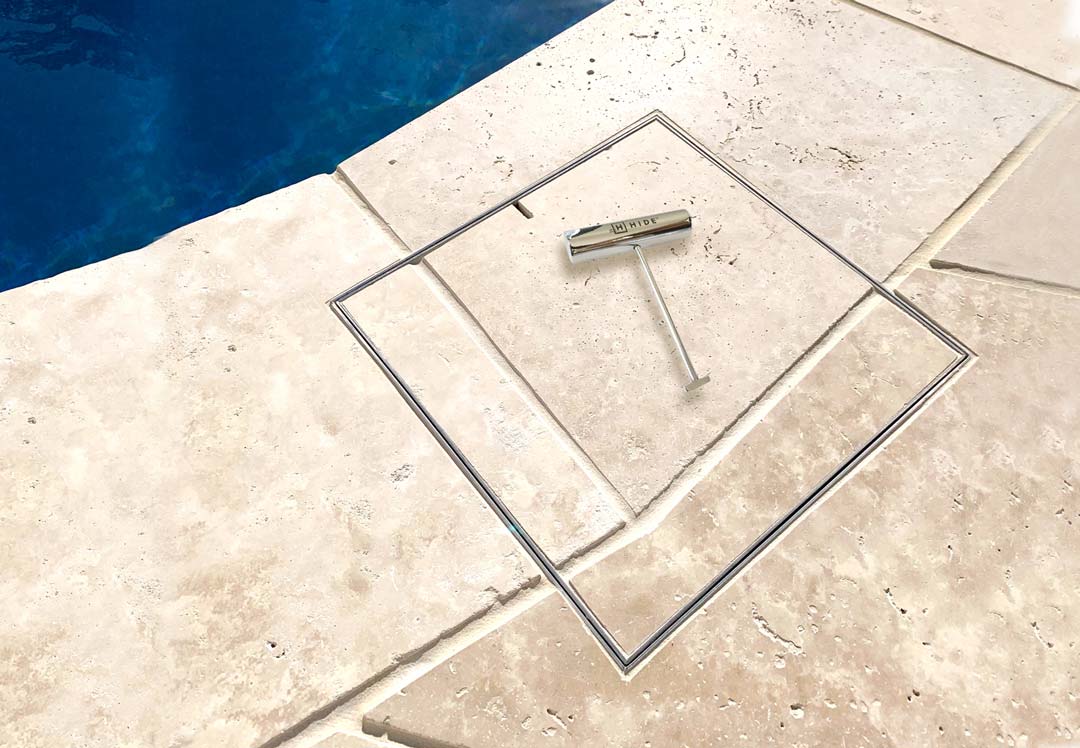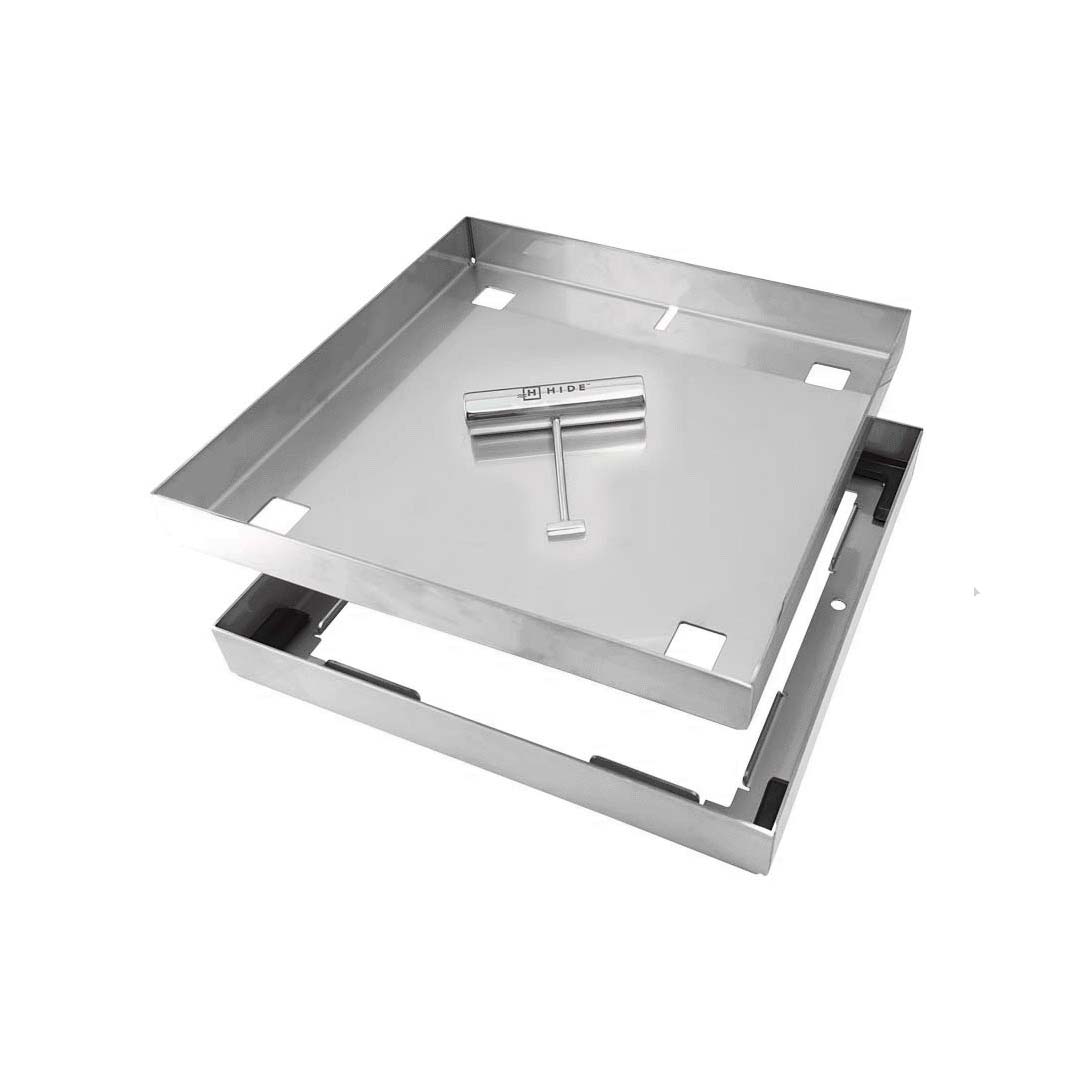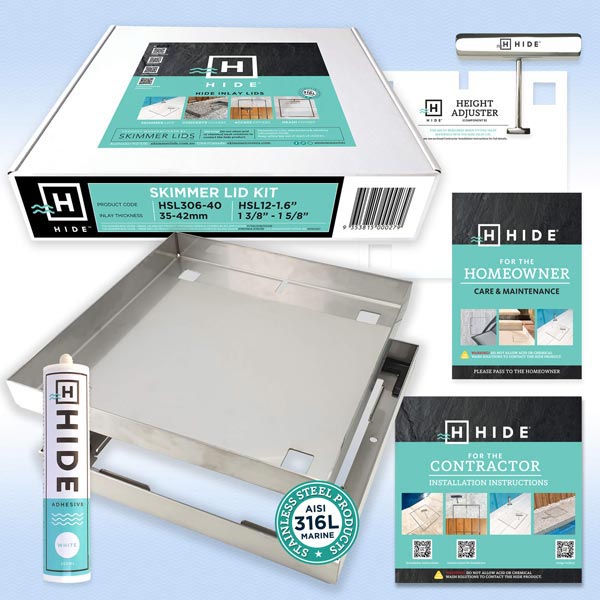Hide Kits
- Free Shipping to North America (Excludes Alaska & Hawaii)
- Warehoused and shipped from Dallas Texas
- This 12" square cover - Available in depths 0.4", 0.8", 1.2", 1.6", 2.0" & 2.5" depths
- Install most materials into the cover - Choose the depth to suit your material
- Concrete conversion supplied (Kits 1.6", 2.0", 2.5" only)
- 316L Marine-Grade Stainless Steel
- 10 year warranty - Maintenance is required
- Install on-site into new or existing pools
- Flush finish making it safe around your pool
- Awarded #1 'Best New Pool Construction Product'
- Distributed throughout North America, Canada, Europe & UK
Skimmer Covers
This 12″ square cover is used to cover skimmer box openings and any external inspection points around your landscape.
Each cover is available in a range of depths to suit most landscape materials. These range from 0.4″ to 2.5″. See the table below for the range of 12″ Skimmer Cover sizes.
See this video about choosing your kit. Click here
Additionally, any HIDE Skimmer Cover may also be used as an access cover.
All Covers 1.6″, 2.0″ and 2 1/2″ in depth include a ‘Concrete Conversion Pack’, enabling wet-pour concrete to be used.
See this video about concrete kits. Click here
Shipping
Free shipping to mainland USA (excludes Alaska and Hawaii)
Please refer Hawaiian sales to:
Maui Pool Masters (Hawaii) P: 808-868-4227 Web: click here
Please refer Canada sales to:
Blades Direct (Canada/USA) Web: click here
Spearhead Marketing (West Canada) P: 604-628-7272
Mitchell Marketing (East Canada) P: 905-577-5902
For all other enquiries, including Europe, please contact Sam Hazell sam.hazell@skimmercovers.com or
Cell: 949-942-4905
Returns Policy
HIDE Skimmer Covers does not charge credit/debit card fees on purchases. However, a 10% administration fee will be charged on all cancelled/returned orders. The customer is also responsible for returning unwanted goods in perfect resaleable condition to our Dallas warehouse. Please contact admin@skimmercovers.com for all order cancellation/return enquiries.
Note: Recess the Bond Beam by at least 5/8″ to allow for the extra depth of the ‘Edge Protector’. Then use mortar as a levelling bed to bring it up to perfect alignment with the top finished surface.
Installation instructions here
Hide Kit Contents

A Quick initiation
1. HIDE Cover
A stainless steel tray which holds your inlay (landscape) materials you’ve chosen e.g. tile, paver, concrete, decking, etc.
2. HIDE Edge Protector
A stainless steel frame inserted into a recess within the landscaped area. It protects the copping/surrounds from chipping/breakage when the inlay cover is opened/closed.
Note that this is 2/3″ deeper than the Cover.
3. HIDE Safety Key
A stainless steel tool to enable the installed HIDE Cover to be safely and easily opened/closed.
4. HIDE Height Adjuster
Used only if your inlay material is not thick enough to achieve a flush finish with the top of the Inlay Cover.
When additional height is required, it allows for extra adhesive to be used on either side of the Height Adjuster, providing up to 5/16″ of extra height.
(Not required in concrete kits).
5. Concrete Conversion Kit
All kits that meet the minimum requirement for concrete wet-pour application will have these kits. (Kits 1.6″, 2.0″ and 2.5″)
6. HIDE Adhesive
(Not required in concrete kits).
7. Documents
Contractor installation instructions, homeowner information and warranty.
BACKED BY A 10 YEAR WARRANTY!
You know you are purchasing a quality product when you receive a 10-year warranty.
And that’s exactly what you receive with a HIDE kit. We offer such a long-standing warranty because our Covers are constructed of high-grade materials which have a beautiful luxurious finish. However, some maintenance is required to keep them looking as good as new. The HIDE warranty covers the Safety Key, the Inlay Cover and the Edge Protector. Read and follow the care and maintenance instructions, kept your Covers clean and away from any harsh acid wash chemicals. Here is a link to some very useful Care & Maintenance advice Click here
Meanwhile, other traditional landscape lid options do not protect and support the stone, and therefore have durability issues that require regular, and often costly, replacement. Due to these durability issues, the homeowner usually receives little to no warranty coverage.
So, which option would you rather?







